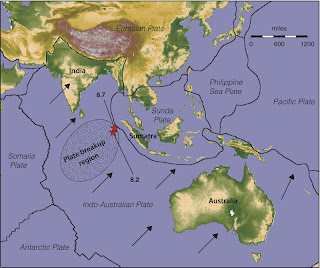8.7 MMS Earthquake Added To Breaking Of Earth Crust
While the breaking up of the Indo-Australian plate of Earth's crust has been long anticipated, seismologists were still left in awe when at least 4 faults broke in an earthquake measuring a magnitude of 8.7. That great Indian Ocean quake on April 2012 may make itself the largest ever recorded.
In all fairness, the previous anticipation was for a gradual breakup of the crust, not the abrupt type as happened. The journal Nature, on its latest Sep.27 issue, also pointed out that the actual quake of April 11, 2012 was 40 % stronger than originally reported of 8.6 magnitudes.
The 4 faults just lie southwest of Sumatra, Indonesia and they all ruptured over a span of 2 minutes and 40 seconds. The tremor traveled far; it was felt from Australia to India.
To put this into perspective, just imagine the 4 ruptures as separate quakes; the corresponding magnitudes would have measured 7.8, 7.9, 8.3 and 8.5, the scientists reported.
Image [Click to enlarge]
The 8.7 main quake and an 8.2 quake (happened 2 hours later) are believed to be the primary factors that broke the Australian and Indian subplates.
All five faults (4 in the 8.7 main quake and 1 in the later 8.2 quake) that broke are considered strike-slip faults, a phenomena which moves ground on one side of the fault laterally across ground on the other side.
In general, seismologists are in agreement that the Sumatra quake is probably the largest intraplate ever recorded.
Why Is There An Absence Of Major Tsunamis?
Theories have been put forward linking the 2012 quake to that of 2004, which resulted massive tsunamis which claimed over 200,000 lives in the same region. It is believed tha the 2004 tragedy has in part triggered the latest quake.
It is fortunate that the latest incident is related to strike-slip faults, which means that there wasn't any significant vertical movement along fault lines – which helps to explain no major tsunamis was generated. The U.S. Geological Survey confirmed that the largest tsunami recorded was just close to 12 inches high, thus posing little risk to life and environment. Another contributing factor is that the small tsunamis occurred not at the coastlines, but further away into the ocean.
Irreversible Beak Up
As a result, the Indo-Australian plate will turn into 2 or perhaps 3 fragments. What is indisputable is that the Apr 2012 quake was unprecedented and it involved a complex chain of fault events. Researchers have been unanimous on that something like this has never been recorded in history of mankind.
Here are the snapshots of that tragic day on Indian Ocean:
- The first quake hit as a fault ruptured through west-northwest to east-southeast. It lasted some 50 seconds with epicenter believed in the region of 100s of miles southwest to Sumatra. It traveled 90-mile (approx) in length, breaking both east-southeastward and west-northwestward, and it also cut into the ground for about 30 miles in depth. This effectively ripped the whole plate apart.
- The second fault ruptured approximately 40 seconds after the first quake. It caused a slippage of approximately 25 feet and the rupture traveled some 60 to 120 miles south-southwest to north-northeast – in direction which is perpendicular to the first rupture.
- The third rupture occurred parallel to the first one at approximately 90 miles apart (southwest). The rupture began after 70 seconds from the first quake and it traveled some 90 miles. It caused a slippage close to 70 feet.
- The fourth rupture happened 145 seconds from the time of first quake and it was parallel to the 1st and 3rd ruptures, but it was over to the northwest. The forth rupture lasted for 15 seconds (total quake time on record is 2 minutes and 40 seconds). Roughly the forth rupture runs for about 30 to 60 miles long. The horizontal movement of the ground is estimated close to 20 feet past ground on the other side of the fault.




Comments
Post a Comment